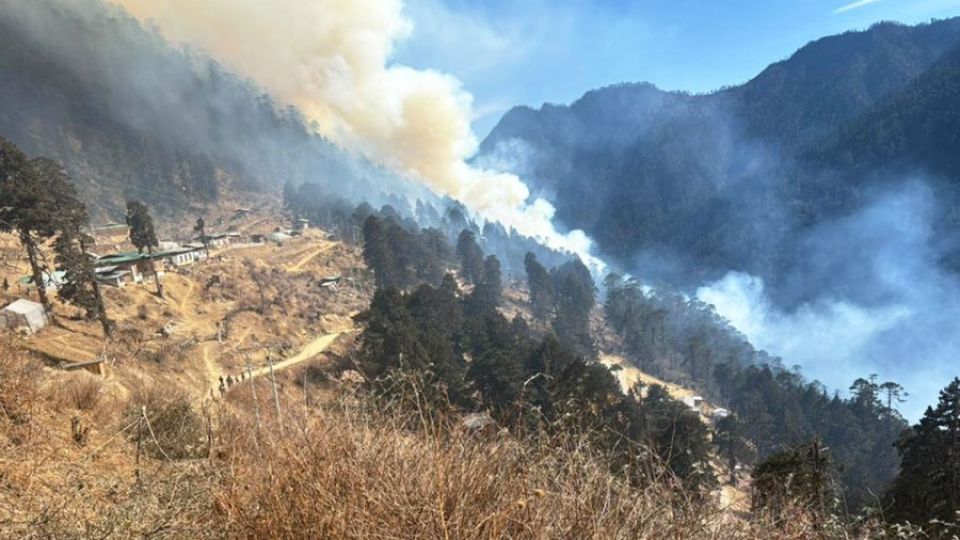April 28, 2025
THIMPHU – Forest fires in the country have resulted in an estimated Nu 520 million worth loss in timber over a five-month period spanning from November 2024 to March 25, 2025, according to a preliminary assessment by the Department of Forests and Park Services (DoFPS).
The recurring incidents, which have ravaged thousands of acres of forest annually, have raised concerns over potential socioeconomic setbacks, the constitutional requirement to maintain 60 percent forest cover, and the country’s carbon-negative status and its commitment to remain carbon neutral.
“Our preliminary findings indicate a substantial Nu 520 million in timber losses within just five months, although fully evaluating the socioeconomic and financial repercussions of past forest fires remains complex,” a DoFPS official said.
The assessment, he added, does not account for additional damages inflicted on essential services and infrastructure, suggesting that the overall financial burden is likely to escalate further.
“Given the magnitude of these losses within such a short time frame, the cumulative financial impact of forest fires over the preceding years is anticipated to be considerably higher,” the official said.
During the peak fire season between November 2024 and March 2025, the DoFPS recorded approximately 50 forest fire incidents, leading to an estimated 12,000 acres of forest being destroyed. Over the past five years (2020-2024), a total of 261 forest fire incidents consumed around 70,696 acres of forest across the country.
These incidents coincide with a gradual decrease in Bhutan’s forest cover. Figures from the National Forest Inventory (NFI) Volume Two, State of Forest Carbon Report (June 2023), show a decline from 2.73 million hectares (71.13 percent) recorded between 2012 and 2015 to 2.67 million hectares (69.71 percent) in 2023.
How much loss is 70,696 acres to forest area
The impact of the 70,696 acres (equivalent to 286 square kilometres) lost to fire in the last five years is significant, even though this area constitutes only about 0.75 percent of Bhutan’s total land area (about 38,294 square kilometres).
It translates to nearly one out of every 130 square kilometres of the country being affected by forest fires in just five years. To illustrate, the area lost is ten times the size of Thimphu city (26 square kilometres) and equivalent to a 2.3-kilometer-wide barren strip along the entire 125-kilometre Paro-Punakha highway.
The destruction of forests, a crucial carbon sink for Bhutan, also plays a threat to the nation’s climate change mitigation efforts. Bhutan’s net carbon dioxide sequestration was reported at 6.79 million tonnes in its 2022 report to the United Nations Framework Convention on Climate Change (UNFCCC). The loss of mature trees, which can absorb 10 to 21 kilograms of carbon dioxide annually, undermines these efforts.
As a major carbon sink, Bhutan’s forests are crucial for achieving national targets and international commitments. The 2023 National Forest Inventory State of Forest Carbon report indicated that Bhutan sequestered 6.79 million tonnes of carbon dioxide.
Consequently, the loss of each tree setbacks the fight against climate change. Although young trees require about five years to absorb significant carbon dioxide, mature trees can absorb 10 to 21 kg annually, accumulating to around one tonne over a 100-year lifespan.
Response against forest fire
Combating forest fires requires considerable manpower and incurs significant costs.
“Estimating the total cost of firefighting efforts over the years is challenging due to limited data, especially on logistical expenses,” a DoFPS official said. “However, between November 2024 and March 2025, around 4,622 firefighters responded to 50 forest fires over 94 days, totaling 434,468 man-days.”
In an effort to prevent these fires, the DoFPS has previously implemented proactive measures, including building strategic firelines, particularly around cultural sites, and conducting prescribed burns in fire-prone zones to reduce flammable vegetation.
The department is currently developing a comprehensive Nationwide Forest Fire Prevention and Response Strategy, informed by past incidents and adapted to the specific risks in various dzongkhags, to improve future prevention and response effectiveness.
Community involvement remains a key component of the department’s approach. About 22 Community-Based Forest Fire Management Groups were established in the past decade and most are currently inactive due to the lapse of management plans and funding constraints.
The DoFPS official said that the new strategy seeks to revitalise and expand these groups in vulnerable regions to cultivate local ownership and strengthen community-level fire prevention.
The department is also exploring the use of advanced technologies like AI-powered surveillance cameras and geospatial systems. “These tools would enable quicker detection, more precise fire modelling, and better post-fire evaluations, ultimately improving the nation’s overall fire response capabilities,” the official said.
The DoFPS also conducts annual awareness campaigns during the dry season through national media outlets and social media to educate the public on preventing forest fires.
The official said that field offices supplement these efforts with localised outreach via events, community meetings, and door-to-door visits in high-risk areas both before and after the fire season.


